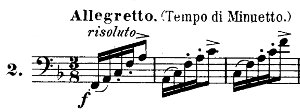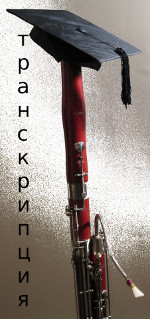Weissenborn Opus 8/2, Study #2 for advanced bassoon students. Increasing air during articulated notes. By Terry B. Ewell, Bassoon Digital Professor. Guest performer Vincent Igusa. Translated by Your Name. BDP#110. www.2reed.net.
Вайссенборн Опус 8/2, этюд № 2 для продвинутых учеников фагота. Увеличение обьема воздуха для артикулириннфвых нот. Терри Б. Юэлл, Цифровый Профессор Фагота. Перевод, Елена Яковлева. BDP # 110. www.2reed.net
TUTORIAL УЧЕБНИК
1.1.Welcome, this is Terry Ewell.
There are three common problems with practicing and performing the 2nd study. First, often this study is performed too fast, with one beat in a measure. Weissenborn intended the study, however, to be performed with three beats in each measure. He provides the tempo allegretto with further instructions tempo di minuetto. This means the tempo of a minuet.
1. Добро пожаловать, это Терри Юэлл. Существуют три обычных проблемы в занятие и исполнение второго этюда. Во-первых, часто этот этюд исполняется слишком быстро, на раз. Однако Вайссенборн предполагал, что этюд должен исполняться в трёхдольном размере. Он представляет собой темп allegretto а потом tempo di minuetto. Это значит, темп менуэта.

2.The second problem is that the slurred notes sound louder than the tongued notes. This is a common problem on wind instruments. Sustained notes sound louder than shorter notes. To correct this, the performer must give more air on the shorter notes to compensate.
2. Вторая проблема заключается в том, что залигованные ноты звучат громче, чем отдельные ноты. Это обычная проблема для духовых инструментов. Длительные ноты звучат громче, чем короткие ноты. Чтобы исправить это, исполнитель должен послать больше воздуха на более короткие ноты, и таким образом, компенсировать.
Examples. Poorly balanced. Well balanced

3.The third problem is that bassoonists often move their jaws when tonguing notes. This is inefficient and at worse it can change the pitch and timbre of the sound. The quality of the air and the position of the embouchure should be the same whether slurred or tongued.
3. Третья проблема заключается в том, что фагонисты часто двигают челюстью при игре стакатто. Это неэффективно, и в худшем случае может изменить высоту нот и тембр звука. Качество воздуха и амбушюр должны быть одинаковыми для легатто и для стакатто.
4.Practice the exercise in front of a mirror to check your embouchure.
4.Занимайтесь этим упражнением перед зеркалом, чтобы следить зо своим амбушюром.
REFLECTION РЕФЛЕКСИЯ
5. Then the LORD God took the man and put him in the garden of Eden to tend and keep it. (NKJV, Genesis 2:15)
5. И взял Господь Бог человека, и поселил его в саду Едемском, чтобы возделывать его и хранить его. (Синодальный перевод, Бытие 2:15)
6. Your garden is everything you do in your life: How you practice your instrument. How you talk with others. How you do your other activities. Consider what you can do to make your garden even more beautiful.
Ваш сад - это все, что вы делаете в своей жизни: как вы занемаитись на своем инструменте, как вы разговариваете с людьми, как вы относитесь к своей деятельностьи. Подумайте, что вы можете сделать, чтобы ваш сад был еще красивее.
